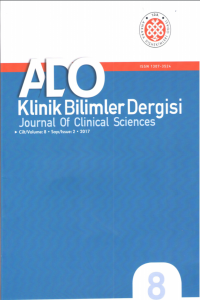Karbon Dioksit Lazerin Ağız Dokularında Kullanımı
Karbon dioksit lazer, oral, endikasyon
The Use of Carbon Dioxide Laser in Oral Tissues
carbon dioxide laser, oral, indication,
___
- Esen E, Haytac MC, Öz A, Erdogan Ö, Karsli ED. Gingival melanin pigmentation and its treatment with the CO2 laser. Oral Surg Oral Med Oral Pathol Oral Radiol Endod. 98:522-527, 2004.
- Haytac MC., Ozcelik O. Evaluatıon of Patıent Perceptions after frenectomy operations: A Comparison of Carbon dioxide laser and scalpel technique. J Periodontol. 77: 1815-1819, 2006.
- Roed-Petersen B. The potential use of CO2-laser gingivec- tomy for phenytoin-induced gingival hyperplasia in men- tally retarded patients. J Clin Periodontol. 20:729- 731,1993.
- Fiorotti RC, Bertolini MM, Nicola JH, Nicola EM Early lin- gual frenectomy assisted by CO2 laser helps prevention and treatment of functional alterations caused by ankylo- glossia. Int J Orofacial Myology 30: 64-71, 2004.
- Bullock N Jr. The use of the CO2 laser for lingual frenecto- my and excisional biopsy. Compend Contin Educ Dent. 16:1118-1123, 1995.
- Pick RM, Pecaro BC, Silberman CJ. The laser gingivectomy. The use of the CO2 laser for the removal of phenytoin hyperplasia. J Periodontol. 56:492-496, 1985.
- Barak S, Kaplan I. The CO2 laser in the excision of gingi- val hyperplasia caused by nifedipine. J Clin Periodontol. 15:633-635, 1988.
- Ünsal E, Paksoy C, Soykan E, Elhan AH, fiahin M. Oral melanin pigmentation related to smoking in a Turkish pop- ulation. Community Dent Oral Epidemiol.29:272-277, 2001.
- Özbayrak S, Dumlu A, Ercalik-Yalcinkaya S. Treatment of melanin-pigmented gingiva and oral mucosa by CO2 laser. Oral Surg Oral Med Oral Path. 90:14-15, 2000.
- Nakamura Y, Hossain M, Hirayama K, Matsumoto K. A clinical study on the removal of gingival melanin pigmen- tation with the CO2 laser. Lasers Surg Med. 25:140-147, 1999.
- Rossmann JA, Israel M. Laser de-epithelialization for enhanced guided tissue regeneration. A paradigm shift? Dent Clin North Am. 44: 793-809, 2000.
- Crespi R, Covani U, Margarone JE, Andreana S. Periodontal tissue regeneration in beagle dogs after laser therapy. Lasers Surg Med. 21:395-402, 1997.
- Israel M, Rossmann JA, Froum SJ. Use of the carbon diox- ide laser in retarding epithelial migration: a pilot histolog- ical human study utilizing case reports. J Periodontol. 66:197-204, 1995.
- Bullock N Jr. The use of the CO2 laser for lingual frenecto- my and excisional biopsy. Compend Contin Educ Dent. 16:1118-1123.,1995.
- Bornstein MM, Winzap-Kalin C, Cochran DL, Buser D. The CO2 laser for excisional biopsies of oral lesions: a case seriesstudy. Int J Periodontics Restorative Dent. 25: 221- 229, 2005.
- Pick RM, Pogrel A, Loh HS. Clinical applications of the CO2 laser: Miserendino LJ, Pick RM. Lasers in Dentistry. Illinois: Quinttessence Publishing Co. 1995, 145-160.
- White JM, Chaudhry SI, Kudler JJ, Sekandari N, Schoelch ML, Silverman S Jr.Nd:YAG and CO2 laser therapy of oral mucosal lesions. J Clin Laser Med Surg. 16: 299- 304,1998.
- Coleton S. Laser treatment of atypical oral pigmentation. A case report. N Y State Dent J. 72:22-23, 2006.
- Chandu A, Smith AC. The use of CO2 laser in the treat- ment of oral white patches: outcomes and factors affecting recurrence. Int J Oral Maxillofac Surg. 34:396-400, 2005.
- Cantarelli Morosolli AR, Schubert MM, Niccoli-Filho W. Surgical treatment of erythroleukoplakia in lower lip with carbon dioxide laser radiation. Lasers Med Sci. 21:181- 184, 2006.
- Guerry TL, Silverman S, Dedo HH. Carbon dioxide laser resection of superficial oral carcinoma: indications, tech- nique and results. Ann Otolaryngol Rhinol Laryngol. 95:547-555, 1986.
- Luomanen M. Experience with a carbon dioxide laser for removal of benign oral soft-tissue lesions. Proc Finn Dent Soc.88: 49-55, 1992.
- Horch HH, Gerlach KL, Schaefer HE. CO2 laser surgery of oral premalignant lesions. Int J Oral Maxillofac Surg. 15:19-24,1986.
- Villarreal Renedo PM, Monje Gil F, Junquera Gutierrez LM, De Vicente Rodriguez JC,, Morillo Sanchez AJ. Treatment of oral and oropharyngeal epidermoid carcino- mas by means of CO2 laser. Med Oral. 9: 172-175, 2004.
- ISSN: 1307-3540
- Yayın Aralığı: Yılda 3 Sayı
- Başlangıç: 2006
- Yayıncı: Ankara Diş Hekimleri Odası
Karbon Dioksit Lazerin Ağız Dokularında Kullanımı
Yeni Bir Bakış Açısı: Kanıt-Destekli Dişhekimliği
Piezoelektrik Cerrahinin Temelleri: Oral ve Maksillofasiyal Cerrahide Kullanımı
Diş Üniti Su Yolu ve Suyu Dental Tedavilerde Risk Oluşturur Mu?
Maksillofasiyal Protezlerin Yapımında Kullanılan Materyallerdeki Gelişmeler
Bilge Turhan BAL, Emre ÖZTÜRK, Seçil KARAKOCA
Ortodontik Tedavide Alt Keser Çekimi
Ömür Polat ÖZSOY, Esen AYDOĞDU
Avulse Üst Daimi Keser Dişin Tedavisi: Multidisipliner Bir Yaklaşım
Kıvanç YAMANEL, Kamran GÜLŞAHI, Alper ÇALAR, Ömür POLAT
Bifosfonat Kullanımına Bağlı Gelişen Mandibula ve Maksilla Nekrozları ve Dental Yaklaşım
Ç Türksel DÜLGERGİL, Ertuğrul ERCAN, Işıl YILDIRIM, Meryem ERCAN, Murat ÖZTÜRK, Mehmet DALLI, Rojan ARCAK
